For over 30 years, the North Shore Group of APS has been running a program to introduce people to the incredible range of native plants in its local Sydney region. Called the ‘Walks & Talks’ program it consists of weekly meetings in which a one hour talk – usually about a particular plant family – is followed by a walk to illustrate the subject of the talk. The group is fortunate to have the 123 hectare Ku-ring-gai Wildflower Garden available for this purpose. Emphasis is placed on participants actually handling plant species and for the talk component of the program labelled specimens are provided for examination. (Permission to collect specimens for this purpose has been obtained and only those plants growing in profusion are used!) Sessions are usually timed to coincide with the flowering of species concerned. Powerpoint presentations are used in all sessions and sets of notes are provided that are freely downloadable from our website: https://austplants.com.au/North-Shore/ (In “notes” on our Walks & Talks page on that site.)
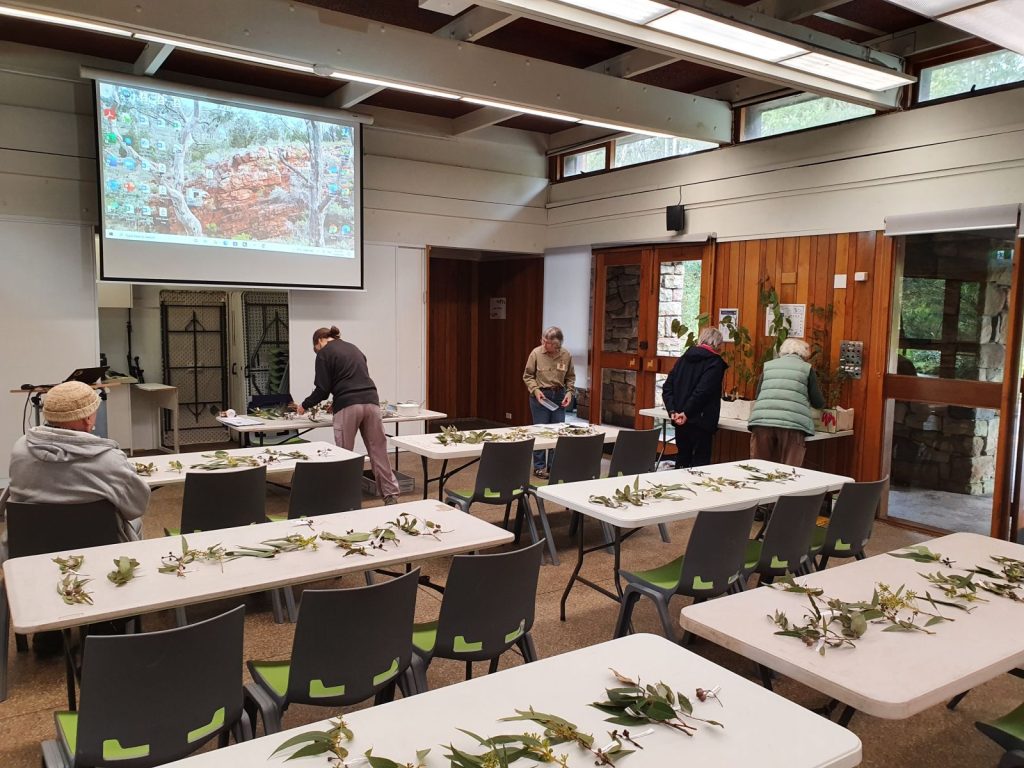
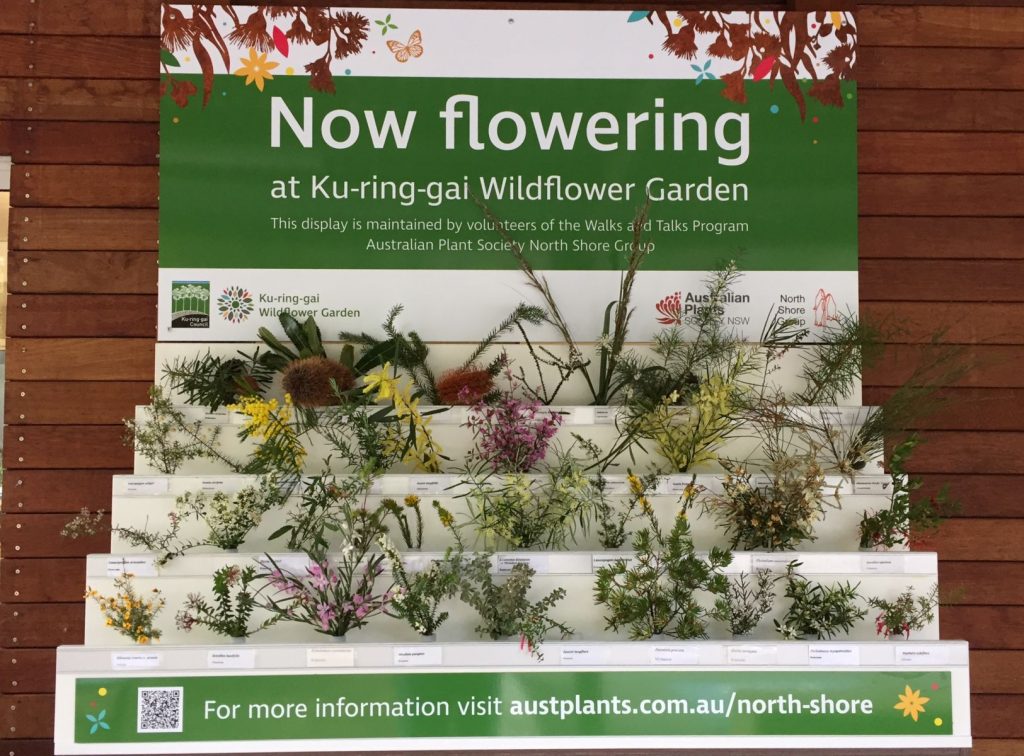
Over the years many of the participants in the program have subsequently joined APS and helped with other activities in the Garden including plant propagation, bush regeneration and a weekly updating of the ‘Now Flowering’ stand.
As the programme has been run on weekdays many participants have been retired people.
Perhaps running the programme on weekends would attract younger participants!
Outline of the Programme for Various Plant Families
Fabaceae, Sub-family Faboideae (The Peas)
Species considered: Kennedia rubicunda, Hovea linearis, Hardenbergia violacea, Glycine microphylla, Mirbelia rubiifolia, Indigofera australis, Gompholobium grandiflorum, latifolium, Dillwynia retorta, floribunda, Platylobium formosum, Bossiaea heterophylla, obcordata, scolopendria, Pultenaea daphnoides, flexilis, stipularis, polifolia, Phyllota phylicoides, Aotus ericoides, Viminaria juncea, Sphaerolobium minus.
From the labelled samples of the pea family provided a large-flowered species is chosen for participants to examine. (Kennedia rubicunda has been found to be a good choice for this purpose.)
With the aid of a hand lens its floral parts are observed as a flower of the species is progressively dismembered.
A corolla of 5 petals (a standard, 2 wings and 2 keel parts), 10 stamens, a carpel (with its stigma, style and superior ovary) and a calyx of 5 fused sepals are observed.
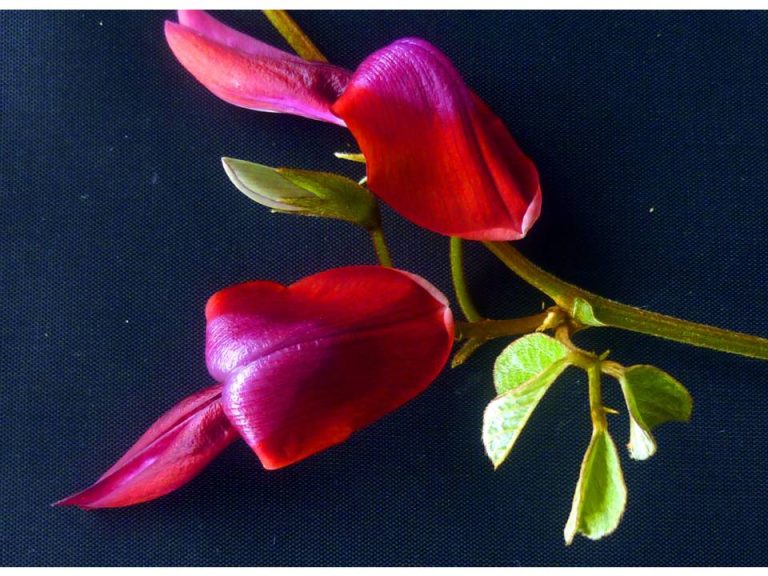
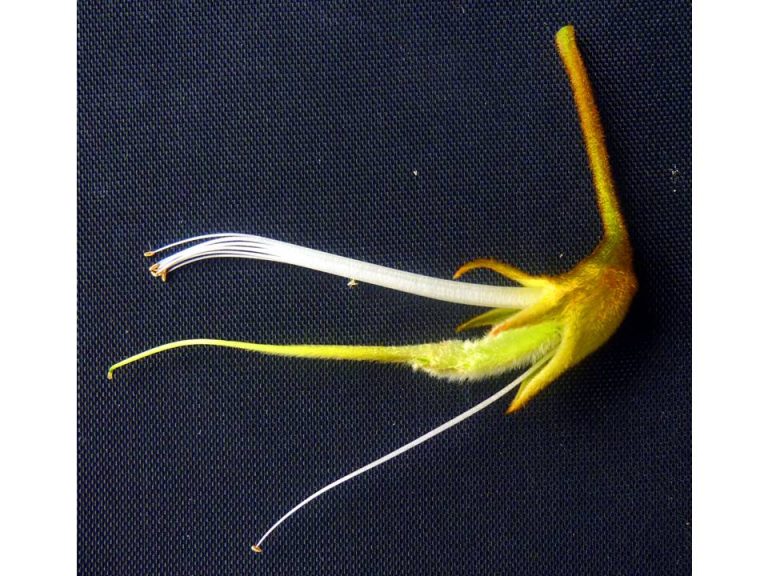
In a powerpoint presentation the species listed above are then described. (Labelled specimens of several of the species are provided for examination.)
Features noted are flower colour, shape of the standard, leaf shape, presence or otherwise of stipules and bracts and nature of its seed pod.
The general features of the family are seen to be:
• Recognisable pea-shaped flowers with five fused sepals, five separate petals (a standard, two wings and two lower petals that form a ‘keel’) and ten stamens
• A superior ovary
• Fruit is a legume (a pod).
Fabaceae, Sub-family Mimosoideae (The Wattles)
Species considered: Acacia baileyana, decurrens, parramattensis, terminalis, elata, ulicifolia, echinula, oxycedrus, binervia, falcata, fimbriata, floribunda, implexa, linifolia, longifolia, melanoxylon, myrtifolia, prominens, suaveolens, vestita.
Attention is first drawn to the distinction between bipinnate and phyllodinous species amongst the labelled specimens. (bipinnate – Acacia decurrens, phyllodinous – Acacia suaveolens, for example.)
The group of prickly phyllodinous species is also noted. (Acacia ulicifolia and Acacia echinula, for example.)
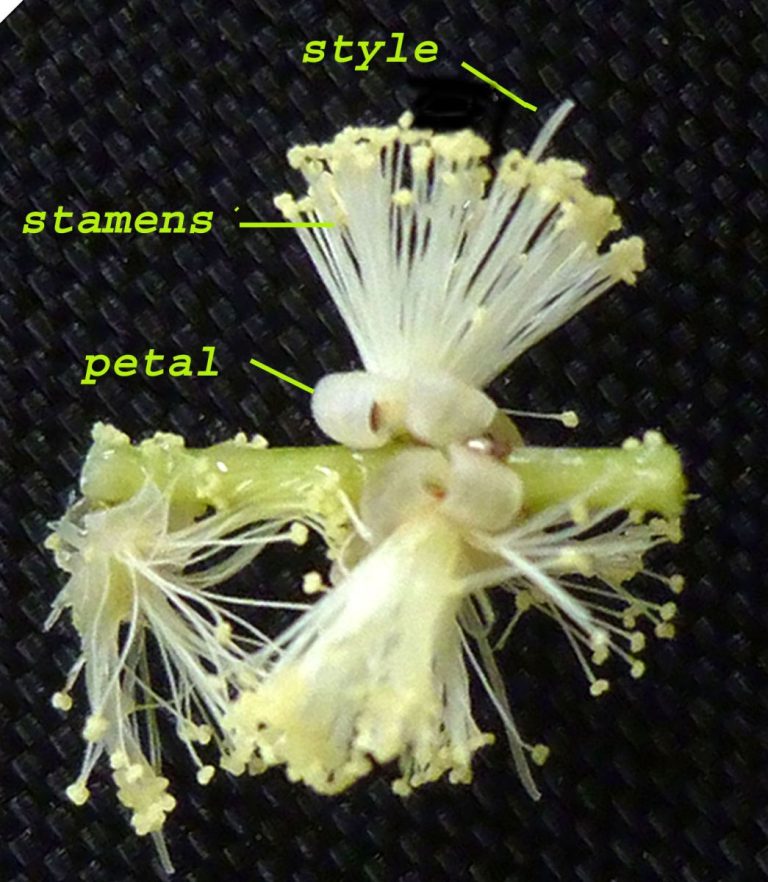
With the aid of a hand lens the floral structure of the tiny Acacia flowers on one of the specimens is observed (5 petals and sepals and a large number of stamens).
A further important distinguishing feature is also noted – whether the species have cylindrical or globular flowerheads (cylindrical – Acacia longifolia, globular – Acacia myrtifolia, for example).
In a powerpoint presentation the above named species are described. (Labelled specimens of several of the species are provided for examination.)
The floral features, the nature of the seed pods, the spacing of pinnae and presence of glands in the bipinnate species and the length and shape of the phyllodes in the phyllodinous species are noted.
The general features of the family are seen to be:
- Bipinnate leaves in seedlings are often replaced by flattened leaf stalks (phyllodes).
- Flowers have 4 or 5 (very small) petals and sepals plus numerous stamens.
- Flowers are grouped together into a head seen as recognisable fluffy balls or rods.
- Fruit is a legume.
Ericaceae
Species considered: Sprengelia incarnata, Dracophyllum secundum, Epacris longiflora, obtusifolia, microphylla, pulchella, Woollsia pungens, Acrotriche divaricata, Leucopogon amplexicaulis, ericoides, juniperinus, microphyllus, setiger, Syphelia tubiflora, Trochocarpa laurina, Monotoca scoparia.
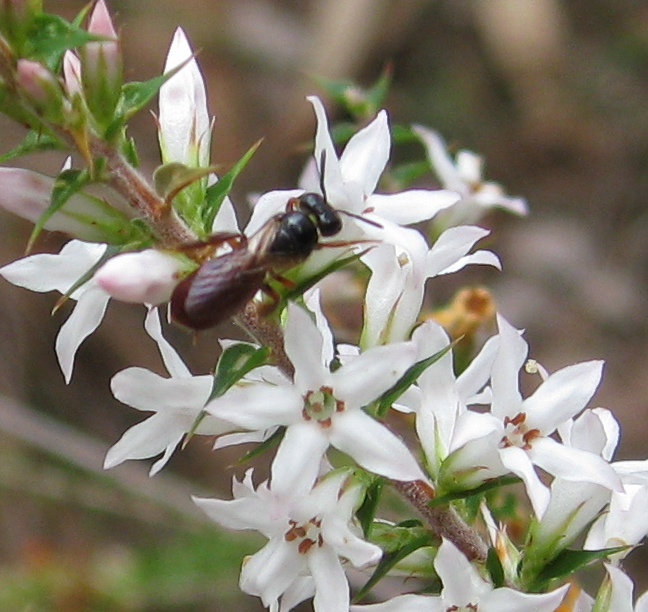
A typical member of the family (Epacris pulchella, for example) is examined by participants. The small, tough, (usually) pointed leaves are noted, and their parallel venation seen using a hand lens. The flower is seen to have five petals, to be regular in shape and to have a superior ovary.
During the course of a powerpoint presentation the following features of the above species are then described (labelled specimens of some of them are provided for examination).
Features noted are whether leaves are pointed (Note Epacris obtusifolia not pointed), whether flowers are solitary or on a spike or raceme, whether flowers are cup-shaped or fused into a tube (including extent of anther if as a tube), whether petals are smooth or hairy or corrugated (Woollsia pungens) and type of fruit (if available).
General features of this family:
- Leaves are small and tough, with parallel venation and usually sharply pointed.
- The flower is regular in shape and petals are often fused into a tube.
- Ovary is superior.
Rutaceae
Species considered: Boronia ledifolia, pinnata, floribunda, fraseri, mollis, serrulata, Correa reflexa, alba, baeuerlenii, Zieria laevigata, pilosa, littoralis, tuberculata, smithii, Eriostemon australasius, Phebalium squamulosum, Leionema dentatum, lamprophyllum, Philotheca myoporoides, salsolifolia, Crowea saligna, exalata, Asterolasia correifolia, elegans.
Two well-known species, Boronia ledifolia and Eriostemon australasius, are first examined as they illustrate many features of this family. The aromatic nature of the leaves is noted and the oil dots in the leaves responsible for this are observed using a hand lens.
For Boronia ledifolia its leaves are seen to be opposite (shiny, dark green above and felty below) and its flowers to be bright pink and 4-petalled.
For Eriostemon australasius its leaves are seen to be alternate (dull green) and its flowers to be pink and 5-petalled.

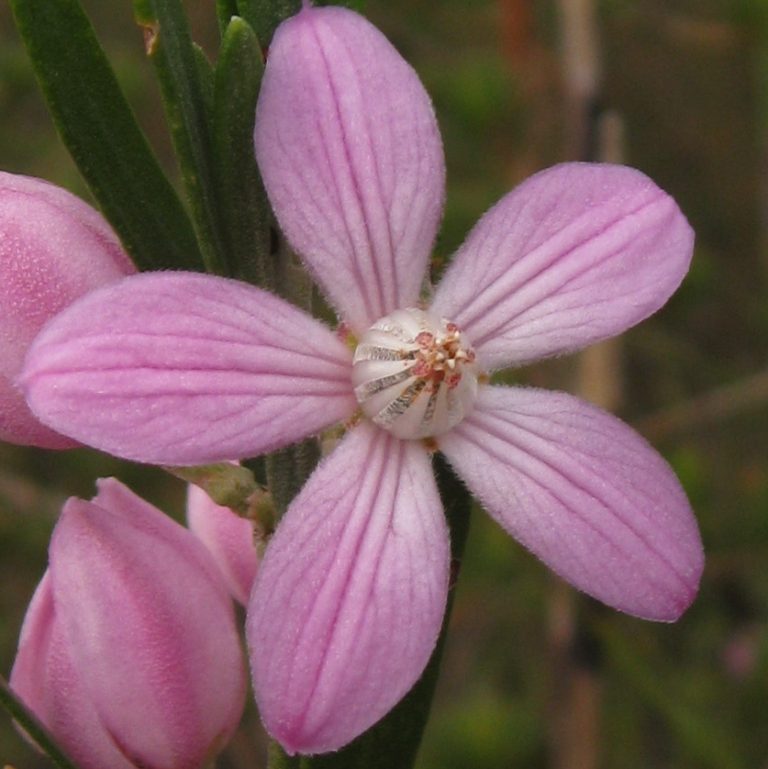
In a powerpoint presentation the species listed above are described. (Labelled specimens of several of the species are provided for examination.)
The following features are specially noted:
- Boronia species – 4 petals, 8 stamens, petals free,
- Correa species – 4 petals, 8 stamens, petals united,
- Zieria species – 4 petals, 4 stamens.
Each of the remaining species listed have flowers with 5 petals. Characteristics of the stamens assist in determining the genus.
General features of this family:
- Leaves contain oil dots and are aromatic when crushed.
- Flowers have 4 or 5 petals.
- Number of stamens is usually equal to or twice the number of petals.
- Fruit consists of 4 or 5 joined carpels.
Proteaceae
Due to the importance and range of the Proteaceae this family is covered over three sessions:
(i) Banksias, (ii) Grevilleas and Hakeas and (iii) Waratahs and Other Members of the Proteaceae Family.
Attention is drawn to taxonomic implications arising from DNA investigations whereby the local species of Proteaceae family are divided into three sub-families:
Subfamily Grevilleoideae
(Flowers occur in pairs, sharing a common bract, fruit a follicle)
Banksia, Grevillea, Hakea, Telopea, Lomatia, Lambertia, Xylomelum
Subfamily Persoonioideae
(Flowers occur singly, styles do not act as a pollen presenter, fruit a drupe)
Persoonia
Subfamily Proteoideae
(Flowers occur singly, fruit nut-like)
Isopogon, Petrophile, Conospermum
Common features of all Proteaceae:
- Many small flowers are packed into a compact head or spike. (There are exceptions!)
- Instead of individual flowers having separate petals and sepals they have four tepals (collectively called the ‘perianth segment’).
- Often, filaments of the four stamens are fused to these tepals.
- In most cases, as the flower matures, the style emerges through the perianth segment, picking up pollen on the way and becoming the ‘pollen presenter’.(This occurs for species in sub-family Grevilleoideae and sub-family Proteoideae but not for those in sub-family Persoonioideae.)
Proteaceae, Subfamily Grevilleoides – Banksias
Species considered: Banksia ericifolia, spinulosa, collina, marginata, oblongifolia, integrifolia, serrata, robur, aemula.
In the ‘hands on’ component of this presentation two labelled banksia spikes are inspected, one having hooked styles and one having straight styles.
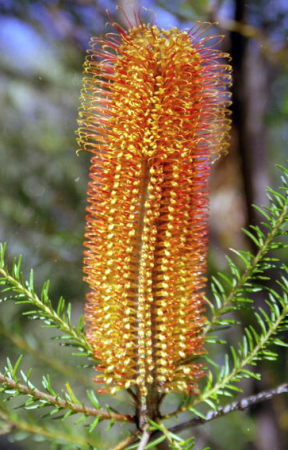
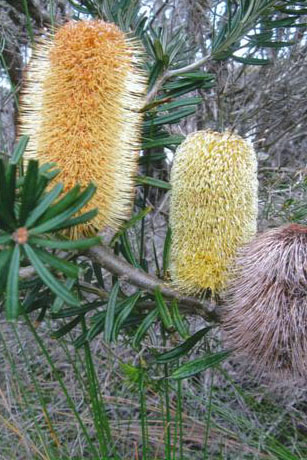
The large number of small flowers on the spike and the ‘hooked’ or ‘straight’ nature of the styles is noted. Some flowers are then teased off one of the spikes. (They are seen to be present on the spike in pairs, a common feature of the subfamily Grevilleoides.)
Using a hand lens the structure of these flowers is observed, (four tepals and the style are seen, the style being attached to the tepals in some cases and broken free from it in others).
In a powerpoint presentation the development of the flower as it matures is discussed. The presence of tepals rather than separate petals and sepals and the way the style becomes a ‘pollen presenter’ is noted as being common for many members of the Proteaceae family.
Labelled specimens of several banksias are then examined.
The following features of each are noted: colour of the flower spike, the hooked or straight nature of the flower and the shape of the leaves. (The importance of leaf shape in identification of banksias is stressed.)
A spike that has developed its fruit (follicles) is observed. (The presence of two winged seeds in each follicle can sometimes be seen.)
Proteaceae, Subfamily Grevilleoides – Grevilleas and Hakeas
Species considered: Grevillea buxifolia, linearifolia, speciosa, caleyi, sericea. Hakea bakeriana, gibbosa, propinqua, sericea, teretifolia, dactyloides, laevipes, salicifolia.
Although Grevillea ‘Robyn Gordon’ (a cross between G. bipinnatifida and G. banksii) is not a local Sydney species its large red flowers are typical of the Grevillea genus. It provides a good specimen for examination of the Proteaceae family and the subfamily Grevilleoides.
One of its flowers can be dismembered to illustrate the 4 tepals, its style and the process that leads to the style becoming the pollen presenter.
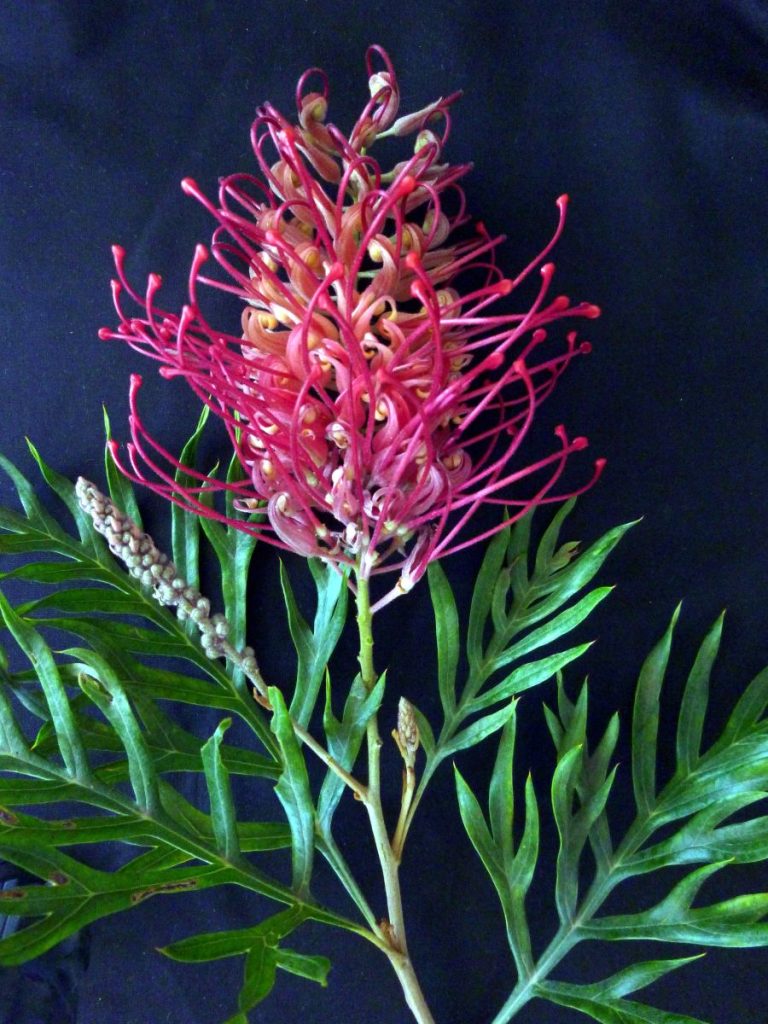
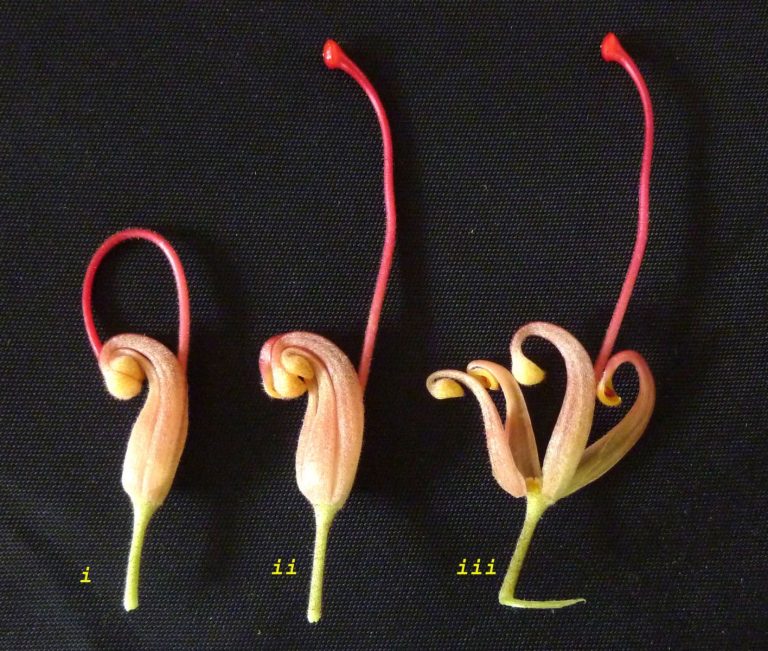
The flowers can also be seen to occur in pairs as they come off the stem of the spike – a common diagnostic feature of the Grevilleoides subfamily.
Amongst the specimens provided an important distinction between grevilleas and hakeas is noted – the inflorescence of grevilleas is most often terminal on the stems whereas for hakeas it is in the leaf axils. All, however, have the common floral arrangement described above.
In a powerpoint presentation the species listed above are described. (Specimens of some of them are provided for examination.)
For the grevilleas the following features are noted: shape of leaves, type of inflorescence (spidery or toothbrush-like) and colour of the inflorescence. (The fruit of all are seen to be follicles of similar shape.) For the hakeas these features are noted: shape of leaves, (flat-leaved or needle-leaved), number of veins for the flat-leaved species, hairiness of new growth, colour of inflorescence and distinctive shapes and wartinesss of the fruit (follicles).
Proteaceae -The Waratah and Other Proteaceae
Species considered: Telopea speciosissima, aspera, oreades, mongaensis, truncata, Lomatia silaifolia, myricoides, Lambertia formosa, Xylomelum pyriforme, Persoonia pinifolia, lanceolata, linearis, levis, Isopogon anethifolia, anemonifolia, Petrophile pulchella, Conospermum longifolium, ericifolium.
Labelled specimens of some of these species are provided for examination.The following features are noted: the types of inflorescence (clusters, spikes, solitary or racemes in leaf axils, for example), leaf details (compound or simple, terete or broad, for example) and type of fruit. Attention is also drawn to the common features of Proteaceae, (compact head or spike of flowers, presence of tepals rather than petals and sepals, style as a ‘pollen presenter’).
(Members of three subfamilies of Proteaceae are included in this set of species. Telopea, Lomatia, Lambertia and Xylomelum species are in the subfamily Grevilleoideae and have flowers in pairs that share a common bract. Persoonia species are in subfamily Persoonioideae and have flowers that occur singly in the axil of a leaf. Isopogon, Petrophile and Conospermum species are in subfamily Proteoideae and have flowers that occur singly. As labelled specimens are examined these subfamily features can be noted.)
Some special characters of the inflorescences of the genera follow: Telopea– a flower cluster with a large number of flowers, Lomatia – paired flowers in a raceme, Lambertia – a flower cluster of 7 flowers surrounded by large red/green bracts, Xylomelum – a spike, Persoonia – solitary single flowers in leaf axils, Isopogon – a globular spike, Petrophile – a conical spike, Conospermum–usually in corymbose panicles on ends of branches.
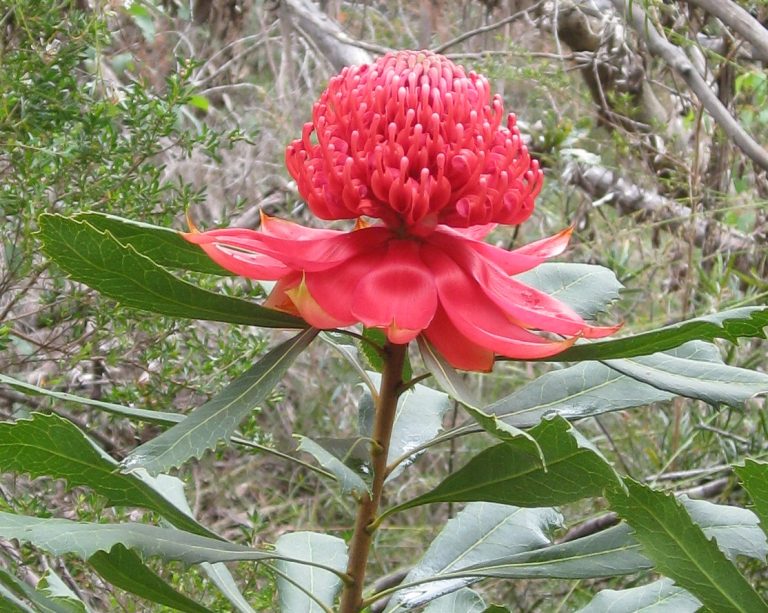
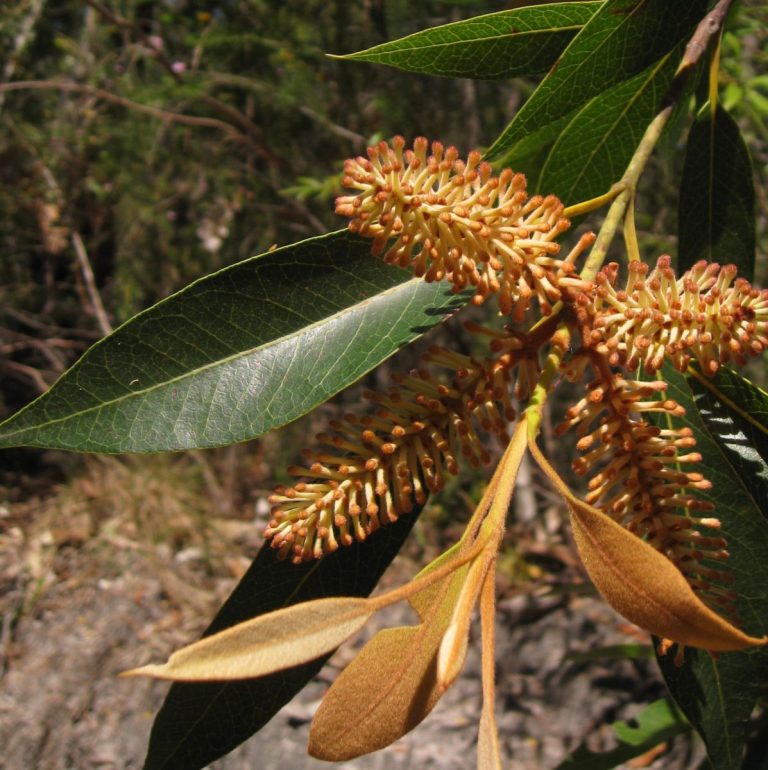
Myrtaceae
Again, due to the range and importance of the Myrtaceae consideration of this family is covered over three sessions – (i) Callistemons, Melaleucas and Kunzeas, (ii) Leptospermums and Baeckeas (some other genera are included), (iii) Eucalypts, Angophoras and Corymbias.
Attention is drawn to taxonomic implications arising from recent DNA investigations whereby genera are placed into various ‘tribes’ within the Myrtaceae family. Genera considered in the three sessions and the tribes to which they belong are as follows:
Tribe Myrteae – Austromyrtus (opposite leaves and more than 60 stamens)
Tribe Leptospermeae – Agonis, Leptospermum, Kunzea (alternate leaves and 20-50 stamens)
Tribe Chamelaucieae – Baeckea, Calytrix, Darwinia, Micromyrtus, Sannantha (opposite leaves and fewer than 25 stamens)
Tribe Melaleuceae – Callistemon, Melaleuca(usually bottlebrush-like inflorescence)
Tribe Eucalypteae – Eucalyptus, Angophora, Corymbia (gum trees)
Common Features of all Myrtaceae
- Leaves contain oil dots and are aromatic when crushed.
- Leaves are entire.
- Flowers are usually regular with 4 or 5 petals and sepals.
- Stamens are often numerous and conspicuous.
Myrtaceae – Callistemons, Melaleucas and Kunzeas (Tribes Melaleuceae and Leptospermeae)
Species considered: Callistemon citrinus, linearis, pinifolius, rigidus, salignus, viminalis, Melaleuca armillaris, deanei, hypericifolia, linariifolia, nodosa, quinquenervia, styphelioides, thymifolia, Kunzea ambigua, capitata.
Using labelled specimens the common features of all Myrtaceae are observed (oil dots in leaves, leaves entire, flowers regular with 4 or 5 petals and sepals, stamens numerous). Any Leptospermum species (although considered in another session) and any Callistemon species (with one of its flowers teased off the inflorescence spike to show the floral parts) can be used for this purpose.
Attention is drawn to the bottlebrush-shaped inflorescence of Callistemons and Melaleucas and the pom-pom-shaped inflorescence of the Kunzea specimens provided. It is noted that the stamens of them all are longer than the petals. (For Kunzea in the Leptospermeae tribe this feature distinguishes Kunzeas from Leptospermums.)
Attention is also drawn to a distinguishing feature between Callistemons and Melaleucas – stamens in Callistemon species are usually free whereas stamens in Melaleuca species are fused into bundles. (Examination with a hand lens is necessary.)
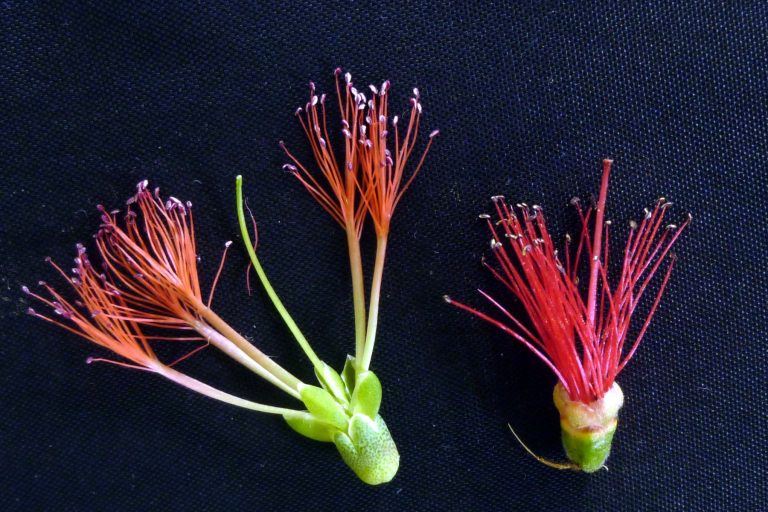
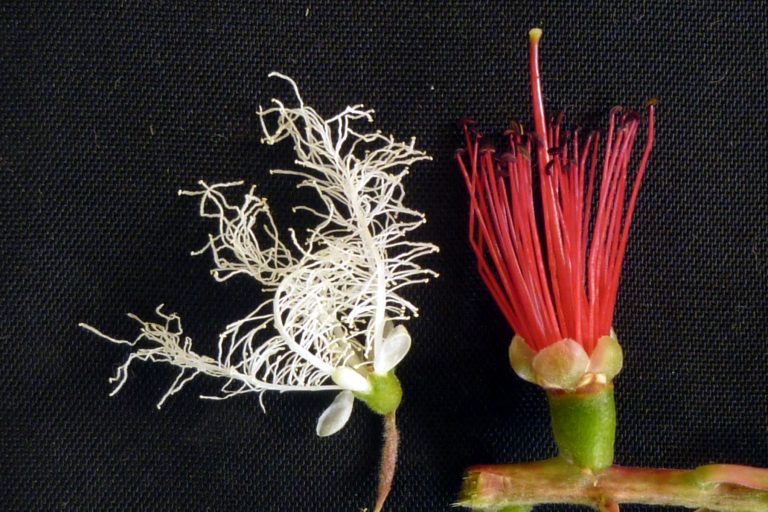
Myrtaceae – Leptospermums and Baeckeas (and various other Myrtaceae genera)
Species considered: Austromyrtus tenuifolia, Leptospermum arachnoides, grandifolium, parvifolium, petersonii, polygalifolium, squarrosum,trinervium, Agonis flexuosa, Baeckea linifolia, Sannantha pluriflora, Calytrix tetragona, Darwinia fascicularis, procera.
Using a labelled specimen of a Leptospermum species (Leptospermum polygalifolium, for example) the common features of all Myrtaceae are first observed – oil dots in leaves, leaves entire, flowers regular with 4 or 5 petals and sepals, stamens numerous.
Tribes and (Genera) |
Leaves |
Stamen Number |
Stamen Length |
|
Myrteae (Austromyrtus) |
Opposite |
Numerous (greater than 60) |
Longer than or equal to petals |
|
Leptospermeae (Leptospermum, Agonis) |
Alternate |
Less numerous (between 30 and 50) |
Shorter than petals |
|
Chamelaucieae (Baeckea, Sannantha, Calytrix, Darwinia) |
Usually opposite |
Few (fewer than 25) |
Shorter than petals |
In a powerpoint presentation the above species are described. Where labelled specimens are available the following features are examined – leaf arrangement (opposite or alternate), the approximate number of stamens and the size of stamens (relative to size of petals). These characters are seen to be consistent with the above table.
Attention is also drawn to some special features of the species examined – the woody capsules of Leptospermum species, the non-woody capsules of Baeckea species, the hairy nature of Calytrix species (due to long hairs that develop at the end of sepals), the protruding styles of Darwinia species.
Myrtaceae – Eucalypts, Angophoras and Corymbias (i.e., Tribe Eucalypteae)
Species considered: Eucalyptus haemastoma, racemosa, luehmanniana, sieberi, piperita, oblonga, capitellata, resinifera, saligna, grandis, elata, robusta, microcorys, sideroxylon, Corymbia gummifera, maculata, ficifolia, torelliana, eximia, Angophora costata, hispida, floribunda, crassifolia.
Although Angophora, Eucalyptus and Corymbia species display all the usual Myrtaceae features (oil dots in leaves, leaves entire, flowers regular with 4 or 5 petals and sepals, numerous stamens) the floral arrangement in Eucalyptus and Corymbia species is very modified. Their petals and sepals are united into a cap – called a calyptra or operculum. This cap is shed as the flower matures leaving a scar on the surface of the fruit (a capsule). Angophora species do not have this character but have sepals reduced to projections on the edge of the floral cup and 4 or 5 overlapping petals.
Labelled specimens are provided for the above features to be examined. Attention is also drawn to the opposite arrangement of leaves in Angophora species and the alternate arrangement of mature leaves in Eucalyptus and Corymbia species.
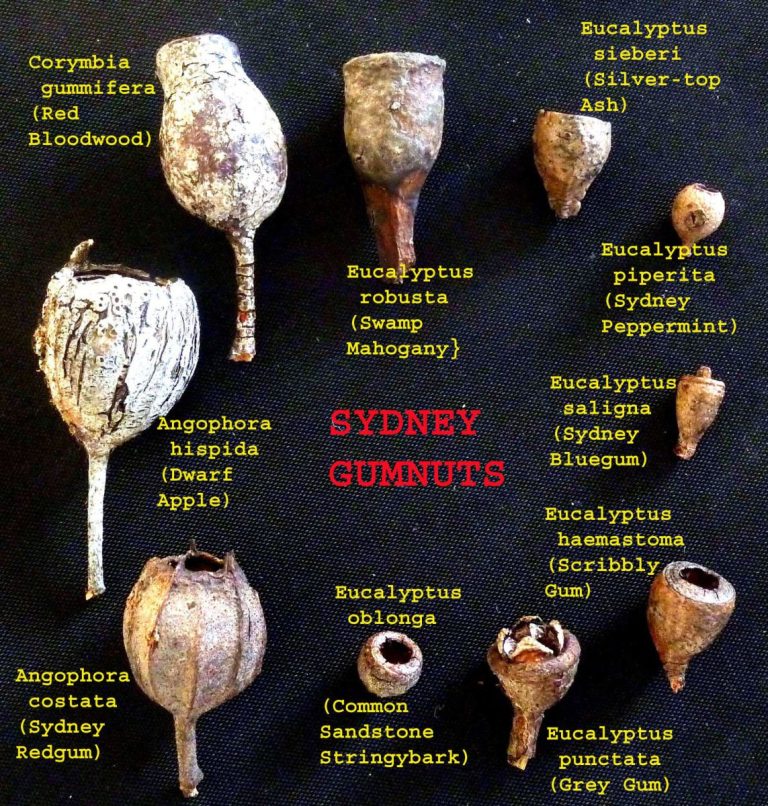
Samples of the fruit of many species are provided for examination and the importance of the shape and size of the fruit in identifying species is emphasised.
Included In the associated powerpoint presentation for this topic is the classification of trees into ‘smooth bark’, ‘part bark’ or ‘full bark’ species and the various types of bark (smooth, stringy, tessellated, for example) that can be present, all important features in identifying species.
Titles of Other Topics Covered (Downloadable notes are available for some of these topics)
An Introduction to Australian Native Plants/ Flowers and Inflorescences/ Leaves and Stems/ Identifying Plants by their Fruits/ Monocotyledons/ Using Botanical Keys/ Orchids/ Grasses/ Mint Bushes/ Ferns/ Fungi/ Asteraceae, Apiaceae and Goodeniaceae/ Hibbertia Guinea Flower/ Lomandras & Grass Trees/ Other Families/ Bush Foods and Fibres/ Birds of Ku-ring-gai Wildflower Garden/ Rainforests/ Fire and the Australian Flora.
Acknowledgements
Most presenters of this program have been (or are currently) members of the North Shore Group of the Australian Plants Society. The successful operation of the program has depended greatly on the capability and enthusiasm of these people.
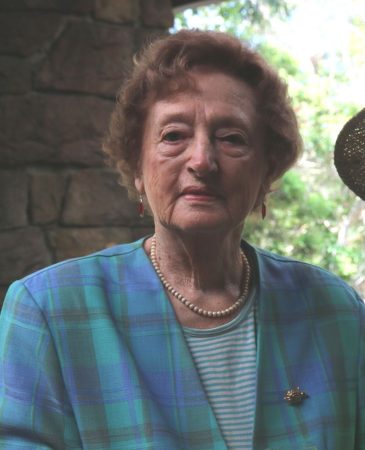
Foundation and early course presenters: Margaret Collins, Hilary Davidson, Pat Hersey, Edith Holmes, Margaret Keith, Jenny Lewis, John McAndrew, Pat Pike, Alex Robertson, Julia Robertson, Susan Saunders, Elaine Stuart, Joan Webb (Foundation Presenter), Mary White (Guest Presenter), Val Williams.
Post 2009 Presenters: Erik Baldry, Michael Batley, Sue Bowen, David Chandler, Glenda Clark, Margarita Clayton, Jill Dalton, Jeannie Davidson, Jenny Edyejones, Tony Evans, Bob Failes, Alec Fisher, Wendy Grimm, Bill Jones, Noela Jones, Fred Langshaw, Barry Lees, Graham McIntosh, Jan Marshall, Marilyn Mason, Ros Mort, Nora Palmer, Bev Robinson, Noel Rosten, Helen Smith, Margery Street, Jenny Talbot, Helen Thiele, Gae Watson, John Williams, Jan Williamson.
We also mention our Latin scholars, Viv Colman and Ron Watts, who expanded on the botanical usage of Latin terms and the non-North Shore Group APS members, Peter Bernhardt, David Branagan, Bob Jones, John Martyn, Bert Oldfield, Jenny Pattinson, Dick Turner, Leslie Waite, Karen Wilson and Barbara Briggs who were guest presenters.
Photo Credits: All photos are by the authors except where shown otherwise.
